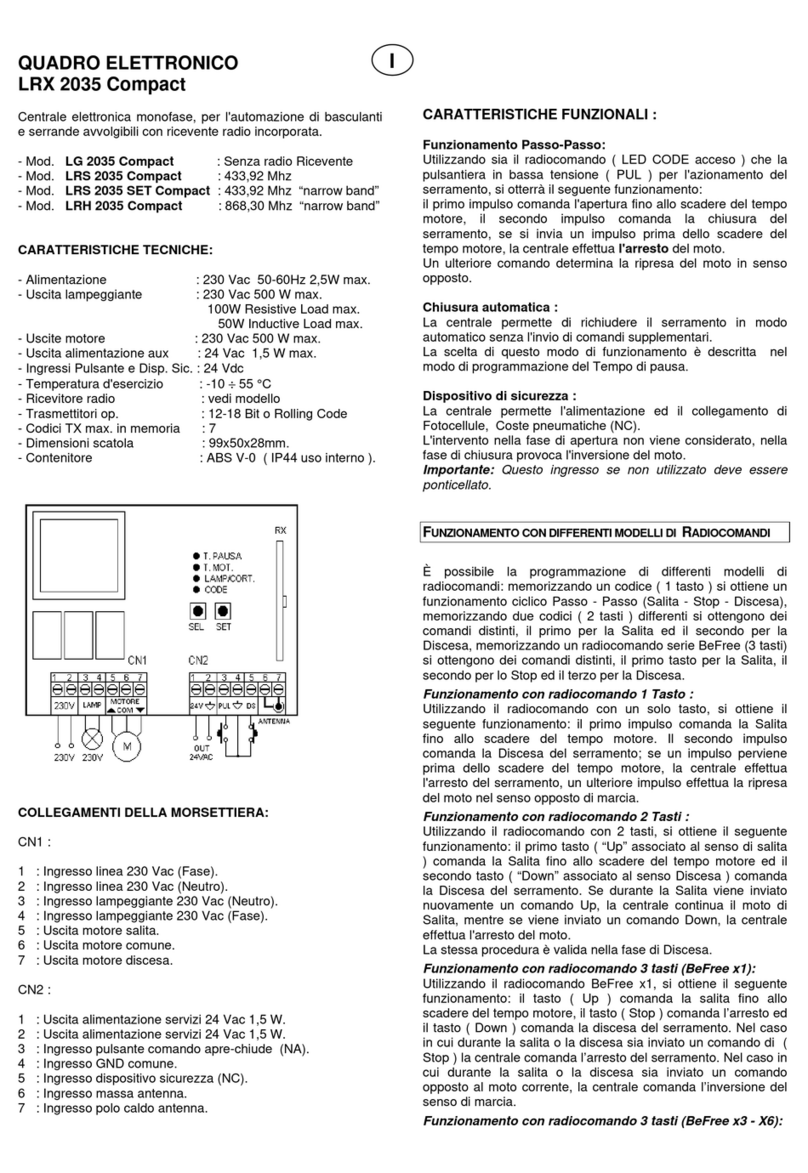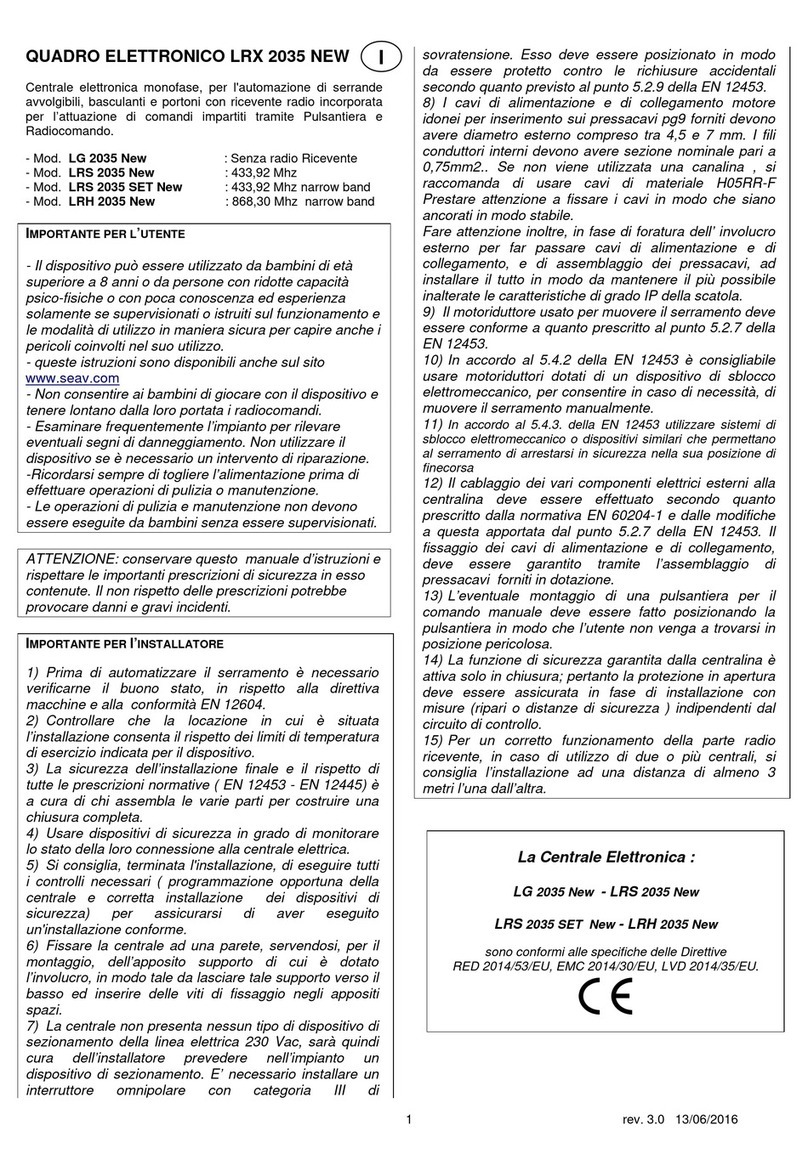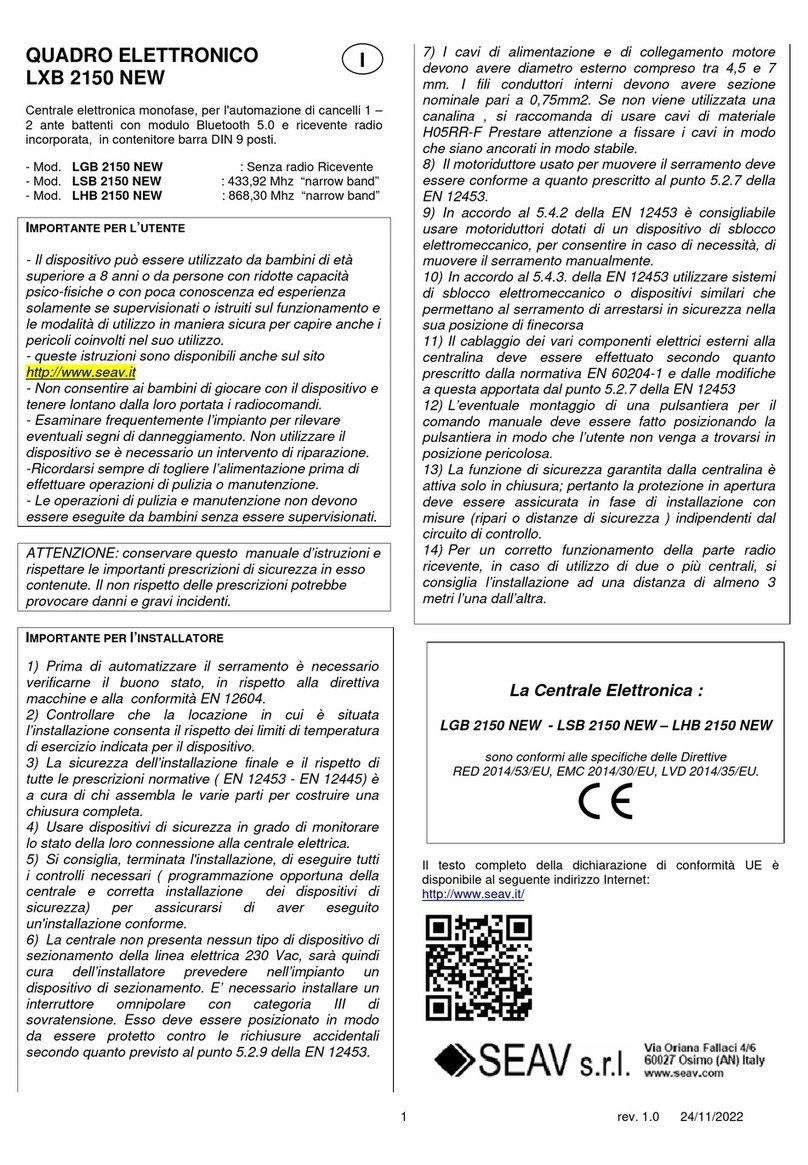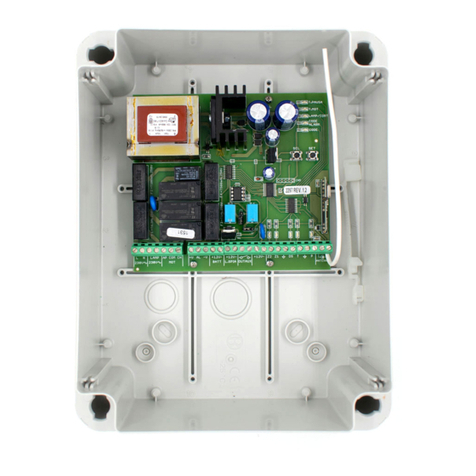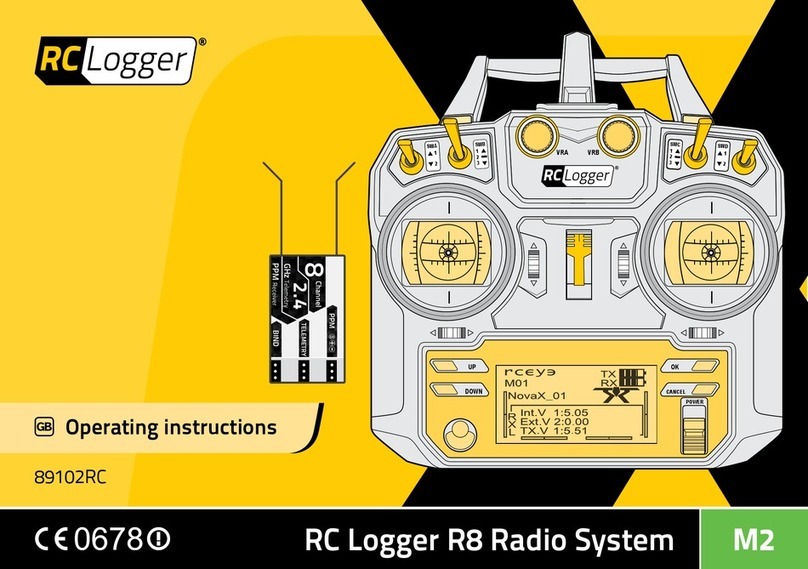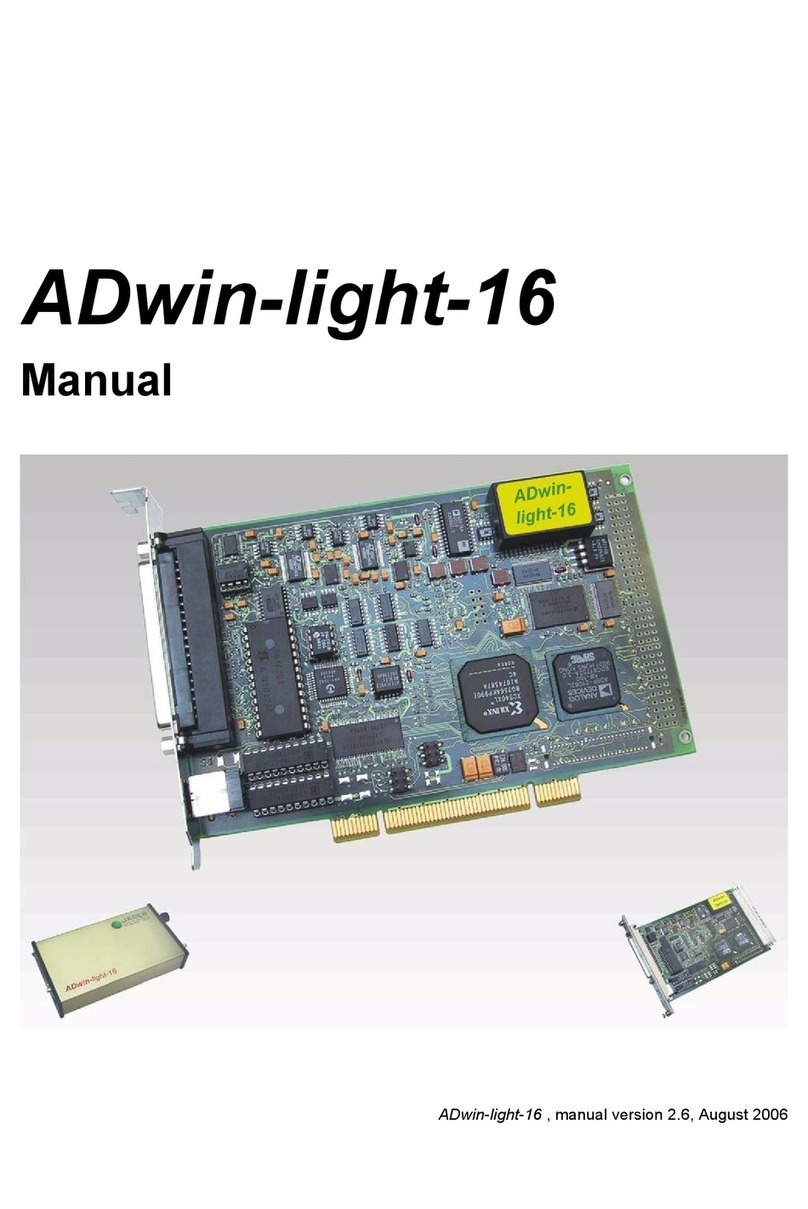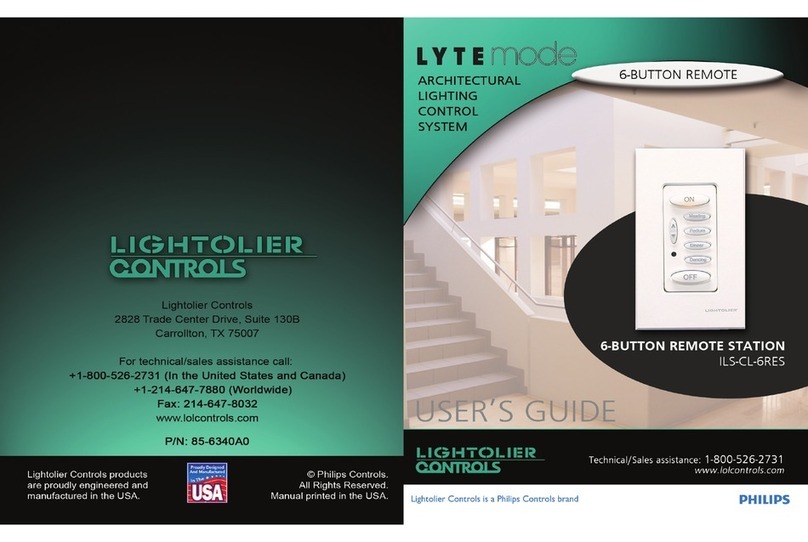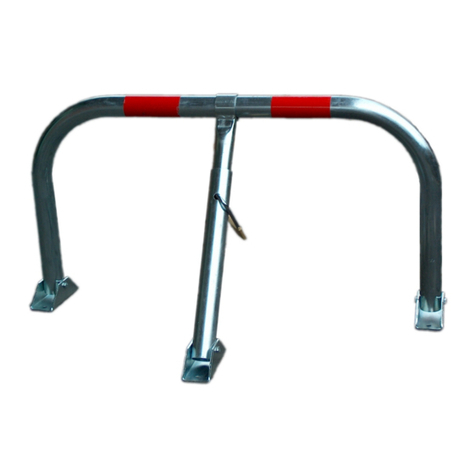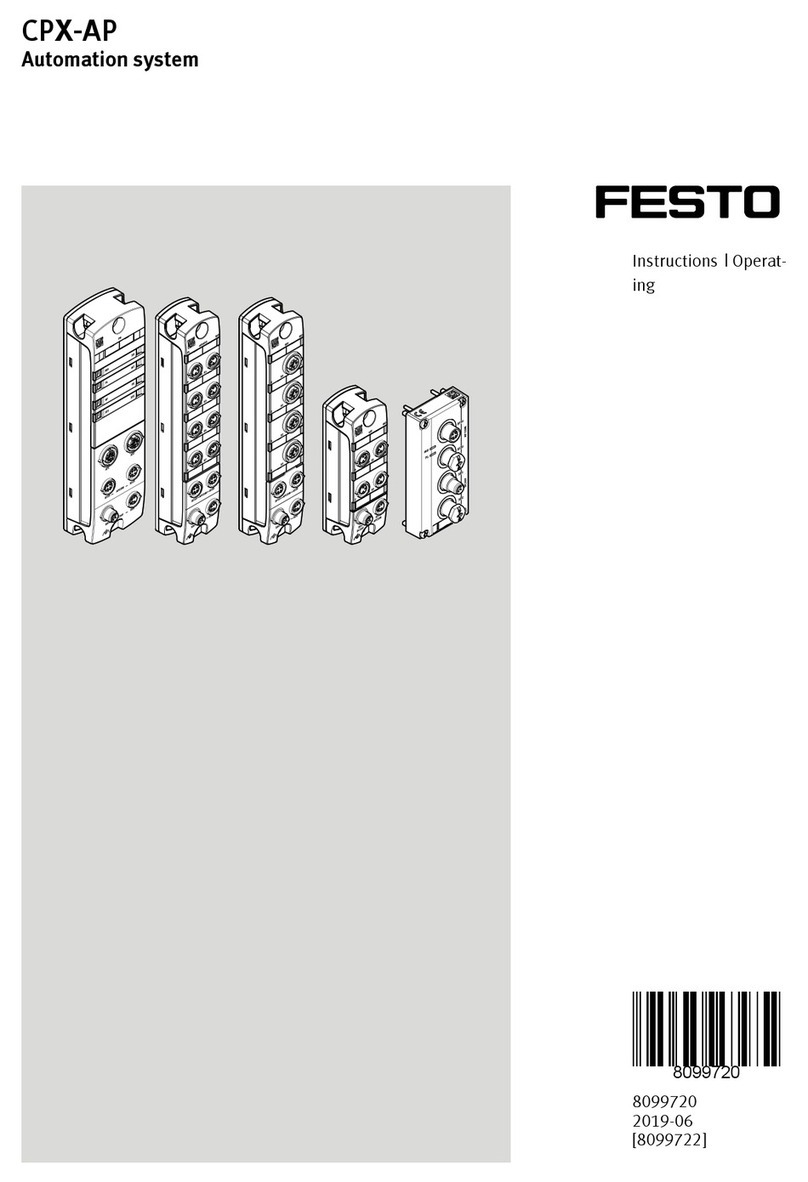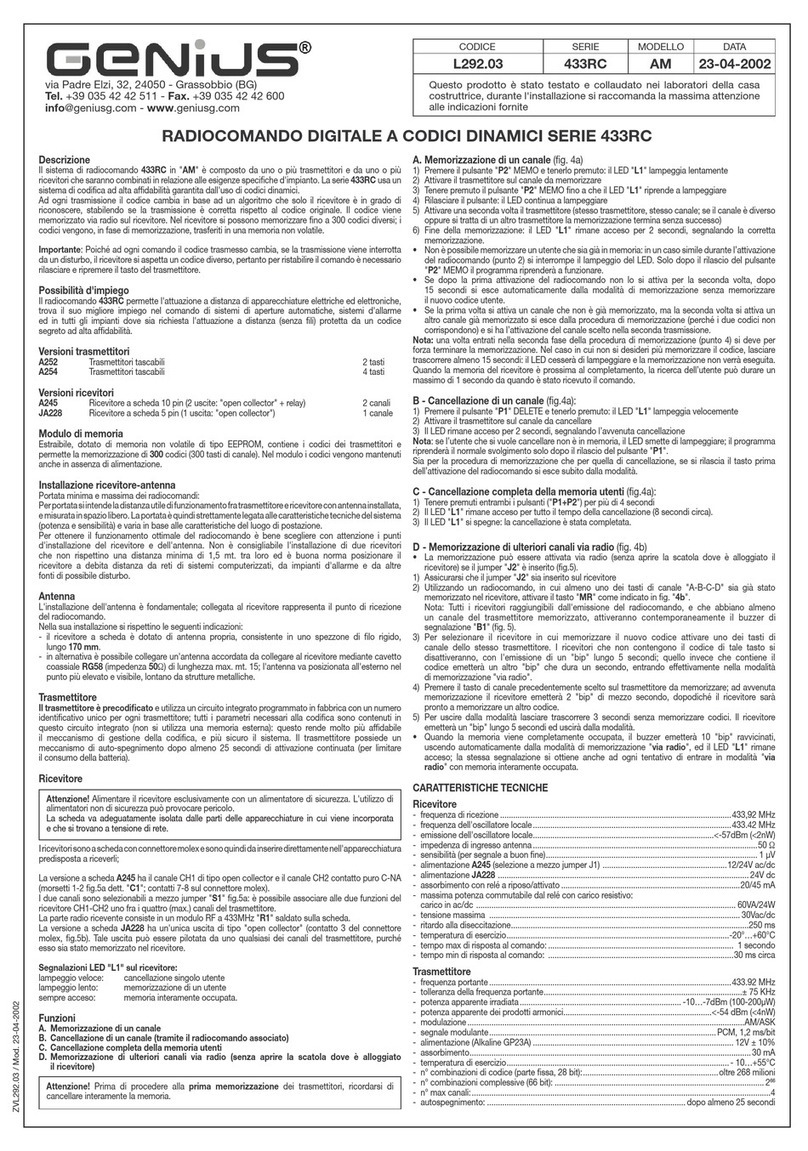Seav LRX 2035 NEW READER User manual

LRX 2035 NEW READER


QUADRO ELETTRONICO
LRX 2035 NEW READER
Centrale elettronica monofase, per l’automazione di serrande avvolgibili,
basculanti e portoni con ricevente radio incorporata per l’attuazione di
comandi impartiti tramite Radiocomando, Transponder, Tastiera digitale e
Smartphone.
La centrale, consente di collegare tramite BUS RS-485 :
- fino a 2 lettori BeSafe Reader New
- fino a 2 selettori BeSafe KEYBOARD
- fino a 2 lettori BeSafe NFC Readerr
- Mod. LG 2035 New Reader : Senza radio Ricevente
- Mod. LRS 2035 New Reader : 433,92 Mhz
- Mod. LRS 2035 New SET Reader : 433,92 Mhz narrow band
- Mod. LRH 2035 New Reader : 868,30 Mhz narrow band
Importante per l’utente
-
Il dispositivo può essere utilizzato da
bambini di età superiore a 8 anni o da
persone con ridotte capacità psico-fisiche
o con poca conoscenza ed esperienza
solamente se supervisionati o istruiti sul
funzionamento e le modalità di utilizzo in
maniera sicura per capire anche i pericoli
coinvolti nel suo utilizzo.
- queste istruzioni sono disponibili anche sul
sito www.seav.com
- Non consentire ai bambini di giocare
con il dispositivo e tenere lontano dalla
loro portata i radiocomandi.
- Esaminare frequentemente l’impianto
per rilevare eventuali segni di danneg-
giamento. Non utilizzare il dispositivo
se è necessario un intervento di ripara-
zione.
- Ricordarsi sempre di togliere l’alimen-
tazione prima di effettuare operazioni di
pulizia o manutenzione.
- Le operazioni di pulizia e manutenzione
non devono essere eseguite da bambini
senza essere supervisionati.
attenzIone:conservare questo manuale
d’istruzioni e rispettare le importanti pre-
scrizioni di sicurezza in esso contenute.
Il non rispetto delle prescrizioni potrebbe
provocare danni e gravi incidenti.
I
3

4
Importante per l’Installatore
1) Prima di automatizzare il serramento è
necessario verificarne il buono stato, in
rispetto alla direttiva macchine e alla
conformità EN 12604.
2) Controllare che la locazione in cui
è situata l’installazione consenta il
rispetto dei limiti di temperatura di
esercizio indicata per il dispositivo.
3) La sicurezza dell’installazione finale e il
rispetto di tutte le prescrizioni normative
(EN 12453 - EN 12445) è a cura di chi
assembla le varie parti per costruire una
chiusura completa.
4) Usare dispositivi di sicurezza in grado di
monitorare lo stato della loro connes-
sione alla centrale elettrica.
5) Si consiglia, terminata l’installazione, di
eseguire tutti i controlli necessari (pro-
grammazione opportuna della centrale
e corretta installazione dei dispositivi
di sicurezza) per assicurarsi di aver ese-
guito un’installazione conforme.
6) Fissare la centrale ad una parete, ser-
vendosi, per il montaggio, dell’apposito
supporto di cui è dotato l’involucro, in
modo tale da lasciare tale supporto
verso il basso ed inserire delle viti di fis-
saggio negli appositi spazi.
7) La centrale non presenta nessun tipo
di dispositivo di sezionamento della
linea elettrica 230 Vac, sarà quindi cura
dell’installatore prevedere nell’impianto
un dispositivo di sezionamento. È neces-
sario installare un interruttore omnipo-
lare con categoria III di sovratensione.
Esso deve essere posizionato in modo
da essere protetto contro le richiusure
accidentali secondo quanto previsto al
punto 5.2.9 della EN 12453.

5
8) I cavi di alimentazione e di collegamento
motore idonei per inserimento sui pres-
sacavi pg9 forniti devono avere diametro
esterno compreso tra 4,5 e 7 mm. I fili
conduttori interni devono avere sezione
nominale pari a 0,75mm2. Se non viene
utilizzata una canalina, si raccomanda
di usare cavi di materiale H05RR-F Pre-
stare attenzione a fissare i cavi in modo
che siano ancorati in modo stabile.
Fare attenzione inoltre, in fase di fora-
tura dell’involucro esterno per far
passare cavi di alimentazione e di col-
legamento, e di assemblaggio dei pres-
sacavi, ad installare il tutto in modo da
mantenere il più possibile inalterate le
caratteristiche di grado IP della scatola.
9) Il motoriduttore usato per muovere il ser-
ramento deve essere conforme a quanto
prescritto al punto 5.2.7 della EN 12453.
10) In accordo al 5.4.2 della EN 12453
è consigliabile usare motoriduttori
dotati di un dispositivo di sblocco
elettromeccanico, per consentire in
caso di necessità, di muovere il ser-
ramento manualmente.
11) In accordo al 5.4.3. della EN 12453 utiliz-
zare sistemi di sblocco elettromeccanico
o dispositivi similari che permettano
al serramento di arrestarsi in sicurezza
nella sua posizione di finecorsa.
12) Il cablaggio dei vari componenti elettrici
esterni alla centralina deve essere effet-
tuato secondo quanto prescritto dalla
normativa EN 60204-1 e dalle modifi-
che a questa apportata dal punto 5.2.7
della EN 12453. Il fissaggio dei cavi di
alimentazione e di collegamento, deve
essere garantito tramite l’assemblaggio
di pressacavi forniti in dotazione.

6
13) L’eventuale montaggio di una pulsan-
tiera per il comando manuale deve
essere fatto posizionando la pulsan-
tiera in modo che l’utente non venga a
trovarsi in posizione pericolosa.
14) La funzione di sicurezza garantita dalla
centralina è attiva solo in chiusura;
pertanto la protezione in apertura deve
essere assicurata in fase di installazione
con misure (ripari o distanze di sicurezza)
indipendenti dal circuito di controllo.
15) Per un corretto funzionamento della parte
radio ricevente, in caso di utilizzo di due o più
centrali, si consiglia l’installazione ad una
distanza di almeno 3 metri l’una dall’altra.
CARATTERISTICHE TECNICHE:
- Alimentazione : 230 Vac 50-60Hz 900W (4A) max.
- Uscita lampeggiante : 230 Vac 50-60 Hz
100W Resistive Load max.
50W Inductive Load max.
- Uscita motore : 230 Vac 50-60Hz 750 W max.
- Uscita alimentazione servizi : 24 Vac 3 W max.
- Sicurezze e comandi in BT : 24 Vcc
- Temperatura d’esercizio : -10 ÷ 55 °C
- Ricevitore radio : vedi modello
- Trasmettitori op. : 12-18 Bit o Rolling Code
- N° dispositivi memorizzabili : 120 max.
- Dimensioni scheda : 100x105 mm.
- Dimensioni scatola : 110x121x47 mm.
- Contenitore : ABS V-0 (IP54).
COLLEGAMENTI DELLE MORSETTIERE:
CN1:
1 : Ingresso linea 230 Vac (Fase).
2 : Ingresso linea 230 Vac (Neutro).
3 : Uscita Lampeggiante 230 Vac (Neutro).
4 : Uscita Lampeggiante 230 Vac (Fase).
5 : Uscita Motore 230V Apertura.
6 : Uscita Motore 230V Comune.
7 : Uscita Motore 230V Chiusura.
CN2:
1 : Alimentazione Fotocellule (24Vac 3W).
2 : Alimentazione Fotocellule (GND).
3 : Ingresso Pulsante comando (NA).
4 : Ingresso GND comune
5 : Ingresso Dispositivo Sicurezza (NC).
6 : Ingresso Massa Antenna.
7 : Ingresso Polo caldo Antenna.
CN3:
1 : Uscita alimentazione 12 VDC Device.
2 : Porta di comunicazione RS 485 signal A.
3 : Porta di comunicazione RS 485 signal B.
4 : Uscita alimentazione 0 VDC Device.
La Centrale Elettronica :
LG 2035 New Reader - LRS 2035 New Reader
LRS 2035 SET New Reader - LRH 2035 New Reader
sono conformi alle specifiche delle Direttive
RED 2014/53/EU, EMC 2014/30/EU, LVD 2014/35/EU.

7
CARATTERISTICHE FUNZIONALI :
Funzionamento Passo-Passo:
Utilizzando sia il Radiocomando, Transponder, Tastiera digitale, Smartphone che i pulsanti in
bassa tensione per l’azionamento del serramento, si otterrà il seguente funzionamento:
Il primo impulso comanda l’apertura fino allo scadere del tempo motore o al raggiungimento
del fine corsa d’apertura, il secondo impulso comanda la chiusura del serramento; se si invia un
impulso prima dello scadere del tempo motore o del raggiungimento di uno dei due finecorsa,
la centrale effettua l’arresto del moto sia nella fase di apertura sia in quella di chiusura. Un
ulteriore comando determina la ripresa del moto in senso opposto.
Modalità di Funzionamento tramite Radiocomando,
Transponder, Tastiera digitale e Smartphone:
La ricevente può essere abbinata a Radiocomandi, Transponder, Tastiere digitali,
Smartphone e permette di memorizzare fino a 120 differenti utenti.
Per l’utilizzo con dei radiocomandi la ricevente è dotata di un ricevitore incorporato; per l’utilizzo
degli altri device sarà necessario collegare l’accessorio desiderato (seguendo con attenzione
gli schemi di collegamento descritti nei relativi manuali di funzionamento) fornito opzional.
Funzionamento con differenti modelli di radiocomandi :
È possibile la programmazione di differenti modelli di radiocomandi: memorizzando un
codice (1 tasto) si ottiene un funzionamento ciclico Passo - Passo (Apertura - Stop - Chiu-
sura); memorizzando due codici (2 tasti) differenti si
ottengono dei comandi distinti, il primo per l’Apertura ed il secondo per la Chiusura;
memorizzando un codice (3 tasti “serie BeFree”) si ottengono tre comandi distinti, il primo
per l‘Apertura, il secondo per lo Stop ed il terzo per la Chiusura.
Funzionamento con radiocomando 1 Tasto :
Utilizzando il radiocomando con un solo tasto si ottiene il seguente funzionamento: il
primo impulso comanda l’Apertura fino allo scadere del tempo motore. Il secondo impulso
comanda la Chiusura del serramento; se un impulso perviene prima dello scadere del
tempo motore, la centrale effettua l’arresto del serramento, un ulteriore impulso effettua
la ripresa del moto nel senso opposto di marcia.
Funzionamento con radiocomando 2 Tasti :
Utilizzando il radiocomando con 2 tasti si ottiene il seguente funzionamento: il primo tasto
(“Up” associato al senso di apertura) comanda l’Apertura fino allo scadere del tempo
motore ed il secondo tasto (“Down” associato al senso Chiusura) comanda la Chiusura del
serramento. Nel caso in cui durante l’Apertura venga inviato nuovamente un comando Up
la centrale continua il moto di Apertura, mentre se ad essere inviato è un comando Down
la centrale effettua l’arresto del moto.
La stessa procedura è valida nella fase di Chiusura.
Funzionamento con radiocomando 3 tasti (Serie BeFree):
Utilizzando i radiocomandi serie BeFree, si ottiene il seguente funzionamento: il tasto Up
comanda l’apertura fino allo scadere del tempo motore, il tasto Stop comanda l’arresto ed il
tasto Down comanda la chiusura del serramento. Nel caso in cui durante l’apertura o la chiusura
sia inviato un comando di Stop la centrale comanda l’arresto del serramento. Nel caso in cui
durante l’apertura o la chiusura sia inviato un comando opposto al moto corrente la centrale
comanda l’inversione del senso di marcia.
Chiusura automatica :
La centrale permette di richiudere il serramento in modo automatico senza l’invio di comandi
supplementari.
La scelta di questo funzionamento è descritta nel modo di programmazione del Tempo di pausa.
Dispositivo di Sicurezza (Fotocellule):
La centrale permette l’alimentazione ed il collegamento di Fotocellule, Coste pneumatiche (NC).
- Ingresso DS (NC)
L’intervento del Dispositivo di Sicurezza nella fase di apertura non viene considerato, nella
fase di chiusura provoca l’inversione del moto.

8
PROGRAMMAZIONE:
Tasto SEL: seleziona il tipo di funzione da memorizzare, la selezione è indicata dal lam-
peggio del Led.
Premendo più volte il tasto, è possibile posizionarsi sulla funzione desiderata. La sele-
zione resta attiva per 10 secondi, visualizzata dal Led lampeggiante, se trascorsi, la cen-
trale ritorna allo stato originario.
Tasto SET: effettua la programmazione dell’informazione secondo il tipo di funzione
prescelta con il tasto SEL. IMPORTANTE: La funzione del tasto SET può anche essere
sostituita dal radiocomando se precedentemente programmato (led CODE acceso).
MENU’ PRINCIPALE
La centrale è fornita dal costruttore con la possibilità di selezionare alcune funzioni importanti.
———————————— MENU’ PRINCIPALE —————————————
Riferimento Led Led spento Led Acceso
1) CODE Nessun codice Codice inserito
2) LAMP./CORT. Lampeggiante Luce di Cortesia
3) T. MOT. Tempo motore 30 sec. Tempo programmato
4) T. PAUSA. Senza chiusura aut. Con chiusura aut.
1) CODE : (Programmazione Radiocomandi e/o Trasponder)
La centrale permette di memorizzare fino a 120 Radiocomandi, Transponder, Tastiere digi-
tali, Smartphone diversi fra loro.
Programmazione di Trasponder, codici della Tastiera o Smartphone NFC :
La programmazione dei dispositivi, è eseguita nel seguente modo: premere il tasto SEL, il
Led CODE inizierà a lampeggiare e allo stesso tempo avvicinare il transponder al lettore di
prossimità BeSAFE Reader New, attivare la BeSafe KeyBoard o avvicinare lo Smartphone
al lettore BeSAFE NFC Reader, il Led CODE diventerà acceso fisso per un istante segna-
lando la memorizzazione; successivamente il Led CODE continuerà a lampeggiare in
attesa di un altro dispositivo da memorizzare per 10 secondi, trascorsi i quali uscirà dal
modo programmazione.
Programmazione del radiocomando 1 o 2 Tasti.
La programmazione dei codici di trasmissione del radiocomando è eseguita nel seguente
modo: premere il tasto SEL, LED CODE inizierà a lampeggiare, allo stesso tempo inviare
il primo codice (“Up” associato al senso di apertura) del radiocomando; a questo punto
il LED CODE inizierà a lampeggiare velocemente: inviare il secondo codice (“Down”
associato al senso di chiusura) da memorizzare, LED CODE rimarrà acceso e la program-
mazione sarà completata. Se non viene inviato il secondo codice entro 10 secondi la
centrale esce dalla fase di programmazione, selezionando il funzionamento con 1 tasto
del radiocomando.
Programmazione del radiocomando 3 Tasti “Serie BeFree”.
La centrale consente con la programmazione del solo Tasto UP la memorizzazione dell’in-
tero radiocomando “BeFree”.
La programmazione dei codici del radiocomando “BeFree” è eseguita nel seguente modo:
premere il tasto SEL, LED CODE inizierà a lampeggiare, allo stesso tempo premere il
tasto UP del radiocomando desiderato; il LED CODE rimarrà acceso e la programmazione
sarà completata.
Cancellazione:
La cancellazione di tutti i dispositivi memorizzati si esegue nel seguente modo: premere
il tasto SEL, LED CODE inizierà a lampeggiare, quindi premere il tasto SET per alcuni
secondi, il LED CODE si spegnerà e la procedura sarà completata.
Segnalazione dispositivo già presente in memoria o non compatibile:
La centrale permette di memorizzare fino a 120 dispositivi aventi codice diverso fra loro.
Nel caso cui si provi ad eseguire la procedura di programmazione di un dispositivo già
presente in memoria o non compatibile, il LED CODE inizierà a lampeggiare velocemente
per qualche istante segnalando l’impossibilità, per poi tornare di nuovo alla fase di pro-
grammazione.
Numero massimo dispositivi memorizzabili :
La centrale permette di memorizzare fino a 120 dispositivi aventi codice diverso fra loro.
Nel caso in cui il numero massimo dispositivi memorizzabili sia stato raggiunto, ripetendo
l’operazione di programmazione, la centrale evidenzia il fallimento dell’operazione effet-
tuando il lampeggio di tutti i led ad eccezione del LED CODE che resta acceso fisso. Dopo
10 secondi la centrale esce dalla programmazione.
2) LAMP/CORT.: (Selezione lampeggiatore o luce di cortesia)
La centrale dispone di una uscita 230Vac, per il collegamento di un lampeggiante o di
una luce di cortesia.
La centrale è fornita dal costruttore con la funzione Lampeggiatore abilitata. Se si desi-
dera abilitare il funzionamento lampeggiatore anche in pausa, procedere nel seguente
modo: posizionarsi con il tasto SEL sul lampeggio del LED LAMP/CORT poi premere il
tasto SET, nello stesso il LED LAMP/CORT si accenderà permanentemente.
Ripetere l’operazione se si desidera ripristinare la configurazione di fabbrica.
Se si desidera abilitare la luce di cortesia, ripetere l’operazione sopra descritta, premendo
il tasto SEL due volte (ottenendo il lampeggio veloce del LED LAMP/CORT) anziché una
volta. Ripetere l’operazione se si desidera ripristinare la configurazione di fabbrica.
3) T. MOT: (Programmazione tempo di lavoro 4 minuti max.)
La centrale è fornita dal costruttore con un tempo di lavoro motore predefinito pari a 30 sec.

9
Se occorre una riprogrammazione del tempo di lavoro motore, deve essere effettuata a
serramento chiuso nel seguente modo: posizionarsi con il tasto SEL sul lampeggio del
LED T. MOT. poi premere in modo continuo il tasto SET, il serramento inizierà la fase di
salita, al raggiungimento del punto desiderato lasciare il tasto SET, nello stesso momento
si determinerà la memorizzazione del tempo motore e il LED T. MOT. sarà acceso fisso. Se
si desidera un tempo di lavoro motore infinito, posizionarsi con il tasto SEL sul lampeggio
del LED T.MOT. poi premere per meno di 1 secondo il tasto SET, nello stesso tempo il Led
si spegnerà e l’operazione sarà completata. Si consiglia di memorizzare un tempo più
lungo di alcuni secondi dopo che il serramento ha raggiunto il finecorsa.
Durante la programmazione è possibile usare al posto del tasto SET, posto sulla centrale,
il tasto del radiocomando solamente se precedentemente memorizzato.
4) T. PAUSA: (Programmazione tempo chiusura aut. 4 min. max.)
La centrale è fornita dal costruttore senza chiusura automatica. Se si desidera abilitare
la chiusura automatica, procedere nel seguente modo: posizionarsi con il tasto SEL sul
lampeggio del LED T. PAUSA, premere per un istante il tasto SET, poi attendere per un
tempo uguale a quello desiderato; premere nuovamente per un istante il tasto SET, nello
stesso momento si determinerà la memorizzazione del tempo di chiusura automatica e il
LED T. PAUSA. sarà acceso fisso. Se si desidera ripristinare la condizione iniziale ( senza
chiusura automatica ), posizionarsi sul lampeggio del LED T. PAUSA poi premere consecu-
tivamente per 2 volte il tasto SET in un intervallo di tempo di 2 secondi. Il Led si spegnerà
e l’operazione sarà conclusa.
Durante la programmazione è possibile usare al posto del tasto SET, posto sulla centrale,
il tasto del radiocomando solamente se precedentemente memorizzato.
MENU’ ESTESO 1
La centrale è fornita dal costruttore con la sola possibilità di selezione diretta delle fun-
zioni del menù principale.
Se si desidera abilitare le funzioni descritte nel menù esteso 1, procedere nel seguente
modo: premere il testo SET in modo continuo per 5 secondi, trascorsi i quali si otterranno
il lampeggio alternato dei Led T.MOT. e Led T. PAUSA in questo modo si avrà 30 secondi
di tempo per selezionare le funzioni del menù esteso 1 mediante l’uso dei tasti SEL e SET,
poi dopo ulteriori 30 secondi la centrale ritorna al menù principale.
————————————— MENU’ ESTESO 1 ————————————
Riferimento Led Led spento Led Acceso
A) CODE PGM a distanza = OFF PGM a distanza = ON
B) LAMP/CORT Passo – Passo Automatico
C) T. MOT. Lampeggio ON/OFF alternato
D) T. PAUSA. Lampeggio ON/OFF alternato
A) CODE (Programmazione Radiocomando a distanza):
La centrale consente la programmazione del codice di trasmissione, senza intervenire
direttamente sul tasto SEL della centrale, eseguendo l’operazione a distanza.
La programmazione del codice di trasmissione a distanza, si esegue nel seguente modo:
inviare in modo continuo per un tempo maggiore di 10 secondi il codice di un radioco-
mando in precedenza memorizzato: allo stesso tempo la centrale entra in modo program-
mazione come sopra descritto per il LED CODE nel menù principale.
La centrale è fornita dal costruttore con la programmazione del codice di trasmissione a
distanza disabilitata, se si desidera abilitare la funzione, procedere nel seguente modo:
assicurarsi di aver abilitato il menù esteso 1 (evidenziato dal lampeggio alternato dei Led
T.MOT. e Led T. PAUSA), posizionarsi con il tasto SEL sul lampeggio del LED CODE poi
premere il tasto SET, nello stesso istante il LED CODE si accenderà permanentemente
e la programmazione sarà conclusa. Ripetere l’operazione se si desidera ripristinare la
configurazione precedente.
B) LAMP/CORT. (Funzionamento Passo – Passo / Automatico):
La centrale è fornita dal costruttore con il modo di funzionamento Automatico disabilitato.
Se si desidera abilitare la funzione, procedere nel seguente modo: assicurarsi di aver
abilitato il menù esteso 1 (evidenziato dal lampeggio alternato dei Led T.MOT. e Led T.
PAUSA), posizionarsi con il tasto SEL sul lampeggio del LED LAMP/CORT poi premere il
tasto SET: nello stesso istante il LED LAMP/CORT si accenderà permanentemente e la
programmazione sarà conclusa.
In questo modo, utilizzando sia il Radiocomando, Transponder, Tastiera digitale,
Smartphone che i pulsanti in bassa tensione per l’azionamento del serramento, si otterrà
il seguente funzionamento: il primo impulso comanda l’apertura fino allo scadere del
tempo motore, il secondo impulso comanda la chiusura del serramento, se si invia un
impulso prima dello scadere del tempo motore, la centrale effettua l’inversione del moto
sia nella fase d’apertura sia in quella di chiusura. Ripetere l’operazione se si desidera
ripristinare la configurazione precedente.
MENU’ ESTESO 2
La centrale è fornita dal costruttore con la sola possibilità di selezione diretta delle
funzioni del menù principale.
Se si desidera abilitare le funzioni descritte nel menù esteso 2, procedere nel seguente
modo: accedere al menù esteso 1 (come descritto nel relativo paragrafo), quindi pre-
mere nuovamente il testo SET in modo continuo per 5 secondi, trascorsi i quali si
otterranno il lampeggio simultaneo dei Led T.MOT. e Led T. PAUSA: in questo modo si
avranno 30 secondi di tempo per selezionare le funzioni del menù esteso 2 mediante
l’uso dei tasti SEL e SET, poi dopo ulteriori 30 secondi la centrale ritorna al menù
principale.

10
———————————— MENU’ ESTESO 2 ————————————
Riferimento Led Led spento Led Acceso
A) CODE Anti-Pass-Back = OFF Anti-Pass-Back = ON
B) LAMP/CORT Uomo presente CH = OFF Uomo presente CH = ON
C) T. MOT. Lampeggio ON/OFF simultaneo
D) T. PAUSA. Lampeggio ON/OFF simultaneo
A) CODE (Anti-Pass-Back):
La centrale è fornita dal costruttore con la funzione Anti-pass-back disabilitata. Se si desi-
dera abilitare la funzione, procedere nel seguente modo: assicurarsi di aver abilitato il menù
esteso 2 (evidenziato dal lampeggio simultaneo dei Led T.MOT. e Led T. PAUSA), posizionarsi
con il tasto SEL sul lampeggio del LED CODE poi premere il tasto SET: nello stesso istante
il LED CODE si accenderà permanentemente e la programmazione sarà conclusa. In questo
modo la centrale funzionerà in modalità Antipassback, ovvero utilizzando una coppia di BeSafe
Reader New, BeSafe KeyBoard e/o BeSafe NFC ( con impostati tra loro differenti indirizzi di
funzionamento, Indirizzo 0 = ingresso, Indirizzo 1 = uscita del serramento ) una volta aperto il
serramento per entrare, sarà necessario aprire il serramento per uscire, prima di poter effet-
tuare uno nuovo ingresso.
Ripetere l’operazione se si desidera ripristinare la configurazione precedente.
B) LAMP/CORT (Funzionamento Uomo Presente):
La centrale è fornita dal costruttore con la funzione di Uomo Presente disabilitata. Se si desi-
dera abilitare la funzione, procedere nel seguente modo: assicurarsi di aver abilitato il menù
esteso 2 (evidenziato dal lampeggio simultaneo dei Led T.MOT. e Led T. PAUSA), posizionarsi
con il tasto SEL sul lampeggio del LED LAMP/CORT poi premere il tasto SET, nello stesso
istante il LED LAMP/CORT. si accenderà permanentemente e la programmazione sarà con-
clusa. In questo modo la centrale funzionerà in modalità Uomo Presente.
Se si desidera abilitare il funzionamento ad Uomo Presente nella sola fase di Chiusura, ripetere
l’operazione sopra descritta, premendo il tasto SEL due volte (ottenendo il lampeggio veloce
del LED LAMP/CORT). Ripetere l’operazione se si desidera ripristinare la configurazione pre-
cedente.
RESET:
Nel caso sia opportuno ripristinare la centrale alla configurazione di fabbrica, premere il
tasto SEL e SET in contemporanea, allo stesso tempo si otterrà l’accensione contempora-
nea di tutti i led ROSSI di segnalazione e dopo alcuni secondi lo spegnimento.
DIAGNOSTICA:
Test input comandi:
In corrispondenza ad ogni ingresso di comando in bassa tensione, la centrale dispone di un
LED di segnalazione, in modo tale da poter controllare rapidamente lo stato.
Logica di funzionamento : LED acceso ingresso chiuso, LED spento ingresso aperto.
GESTIONE LED DI PROGRAMMAZIONE:
La centrale dopo 3 minuti di inattività nella procedura di programmazione, effettua lo spe-
gnimento automatico dei LED di programmazione per risparmio energetico. La sola pres-
sione dei tasti SEL, SET o il ricevimento di un comando di moto, attiverà l’accensione dei
LED in base alle programmazioni impostate precedentemente.
TERMINAZIONE BUS RS-485:
La comunicazione BUS avviene mediante standard RS485.
È possibile effettuare collegamenti con cavi di lunghezza fino a 100 m.
Nel caso si verifichino problemi di comunicazione si consiglia di spostare il Jumper J1
in posizione 1-2 (inserimento della resistenza di terminazione) sui dispositivi situati agli
estremi dei collegamenti:
J1 pos. 1-2 = resistenza di terminazione inserita.
J1 pos. 2-3 = resistenza di terminazione non inserita( default).
Il testo completo della dichiarazione di conformità UE è disponibile al seguente indirizzo
Internet: http://www.seav.it
Rev. 3.1 03/08/2017
1 Rev. 3.1 03/08/2017
It aliano:
Il testo completo della dichiarazione di conformità UE è
disponibile al seguente indirizzo Internet:
http://www.seav.it
In gl ese:
The full text of the EU Declaration of Conformity is
available at the following Internet address:
http://www.seav.it
Fr a n cese:
Le texte intégral de la déclaration de conformité C'est
disponible à l'adresse Internet suivante:
http://www.seav.it
Tedesco:
Der vollständige Wortlaut der EU-Konformitätserklärung
ist unter folgenden Internet-Adresse zur Verfügung:
http://www.seav.it
Spagnolo:
El texto completo de la declaración de conformidad de la
UE está disponible en la siguiente dirección de Internet:
http://www.seav.it
Portoghese:
O texto completo da declaração UE de conformidade
está disponível no seguinte endereço Internet:
http://www.seav.it
Svedese:
Den fullständiga texten av EU-försäkran om
överensstämmelse finns på följande Internetadress :
http://www.seav.it
Olandese:
De volledige tekst van de EU-conformiteitsverklaring is
beschikbaar op het volgende internetadres:
http://www.seav.it
Gr eco :
Το πλήρες κείμενο της δήλωσης συμμόρφωσης ΕΕ είναι
διαθέσιμες στην ακόλουθη διεύθυνση στο Διαδίκτυο:
http://www.seav.it
Nota : Rev. 3.1 Aggiornamento globale alla Rev. 3.0

ELECTRONIC PANEL
LRX 2035 NEW READER
Single-phase electronic control unit for the automation, doors and rolling
shutters with incorporated radio receiver for the implementation of com-
mands given via Radio control, Transponder, Digital keyboard and Smart-
phone.
The following can be connected to the control unit via BUS RS-48:
- up to 2 BeSafe Readers New
- up to 2 BeSafe KEYBOARD selectors
- up to 2 BeSafe NFC Readers
- Mod. LG 2035 New Reader : Without radio receiver
- Mod. LRS 2035 New Reader : 433,92 Mhz
- Mod. LRS 2035 New SET Reader : 433,92 Mhz narrow band
- Mod. LRH 2035 New Reader : 868,30 Mhz narrow band
Important for the user
- The device can be used by children
over 8 years of age and persons with
reduced physical or psychological abili-
ties or with little knowledge and expe-
rience only if supervised or educated in
its operation and safe use, in order to
also understand the dangers involved in
its use.
- These instructions are also available at
the website www.seav.com
- Do not allow children to play with the
device and keep the radio controls
away from their reach.
- Frequently examine the system to
detect any signs of damage. Do not use
the device if it is in need of repair work.
- Always remember to disconnect the
power supply before carrying out any
cleaning or maintenance.
- Cleaning and maintenance must not be
carried out by unsupervised children
attentIon:keep this instruction manual
safe and observe the important safety
requirements contained herein. Failure
to comply with the requirements may
cause damage and serious accidents.
GB
11

12
Important for the Installer
1) Before automating the frame, check that
it is in good condition, in compliance
with the Machinery Directive and with
EN 12604.
2) Check that the location where the
installation is located enables com-
pliance with operating temperature
limits specified for the device.
3) The safety of the final installation and
compliance with all prescribed Stan-
dards (EN 12453 - EN 12445) is the
responsibility of the person who assem-
bles the various parts to construct a
total closing.
4) Use safety devices capable of monitor-
ing the status of their connection to the
electrical control unit.
5) Once installation is finished, it is rec-
ommended that all necessary checks
be performed (appropriate program-
ming of the control panel and cor-
rect installation of safety devices) to
ensure that compliant installation has
been performed.
6) Fix the control unit to a wall, using the
relevant support which is fitted to the
casing, in such a way as to leave said
support facing downwards and insert
the fixing screws in the special holes.
7) The control unit does not have any
type of isolating device for the 230
Vac line. It is therefore the respon-
sibility of the installer to set up an
isolating device inside the system. It
is necessary to install an omnipolar
switch, surge category III. It must be
positioned to provide protection from
accidental closing, pursuant to point
5.2.9 of EN 12453.

13
8) Cables for power and connection to the
motor suitable for insertion in the pg9
cable glands provided must have an out-
side diameter between 4.5 and 7 mm.
The internal conductors wires must have
a nominal section of 0.75mm2. If a race-
way is not used, use H05RR-F cables.
Pay careful attention when fastening
the cables so that they are anchored in a
stable manner.
Furthermore, care is required when
drilling holes in the outside casing
where connecting and power supply
cables will pass, and when assem-
bling the cable glands, so that every-
thing is installed so as to maintain the
panel’s IP protection characteristics.
9) The gear motor used to move the
frame must comply with the require-
ments of point 5.2.7 of EN 12453.
10) In compliance with 5.4.2 of EN 12453,
it is recommended to use gear motors
equipped with an electrical-mechani-
cal release device, so that the frame
can be moved manually in case of
necessity.
11) In compliance with 5.4.3. of EN
12453, use electrical-mechanical
release systems or similar devices
which stop the frame safely in the
end run position.
12) The various electrical components
external to the control unit must be
cabled in accordance with standard
EN 60204-1 as amended, and as set
forth in point 5.2.7 of EN 12453. The
power and connection cables must
be secured through the use of cable
glands supplied.
13) The assembly of a push button panel

14
for manual control must be completed
positioning the push button panel in
such a way that the user is not placed
in a dangerous position.
14) The safety function ensured by the con-
trol unit is active only during closing,
therefore, protection on opening must
be ensured in the installation phase with
measures (guards or safety distances)
independent of the control circuit.
15) For proper functioning of the radio receiver,
if using one or more control units, the instal-
lation at a minimum distance of at least 3
metres one from the other is recommended.
TECHNICAL DATA:
- Power supply : 230 Vac 50-60Hz 900W (4A) max.
- Flashing light output : 230 Vac 50-60 Hz
100W Resistive Load max.
50W Inductive Load max.
- Motor output : 230 Vac 50-60Hz 750 W max.
- Services power supply output : 24 Vac 3 W max.
- Safety devices and controls in BT : 24 Vcc
- Operating temperature : -10 ÷ 55 °C
- Radio receiver : see model
- Op. transmitters : 12-18 Bit or Rolling Code
- No. of devices that can be stored : 120 max.
- Board dimensions : 100x105 mm.
- Dimensions of container : 110x121x47 mm.
- Container : ABS V-0 (IP54).
TERMINAL BOARD CONNECTIONS:
CN1:
1 : 230 Vac line input (Phase).
2 : 230 Vac line input (Neutral)
3 : 230 Vac Flashing light Output (Neutral).
4 : 230 Vac Flashing light Output (Phase).
5 : Opening 230V Motor Output.
6 : Common 230V Motor Output.
7 : Closing 230V Motor Output.
CN2:
1 : Power supply to photocells (24Vac 3W).
2 : Power supply to photocells (GND).
3 : Control button input (NA).
4 : Common GND input
5 : Safety device input (NC).
6 : Aerial earth input.
7 : Aerial hot pole input.
CN3:
1 : Power supply output 12 VDC Device.
2 : Communication port RS 485 signal A.
3 : Communication port RS 485 signal B.
4 : Power supply output 0 VDC Device.
The electronic control unit:
LG 2035 New Reader - LRS 2035 New Reader
LRS 2035 SET New Reader - LRH 2035 New Reader
they comply with the specifications of the Directives
RED 2014/53/EU, EMC 2014/30/EU, LVD 2014/35/EU.

15
OPERATING FEATURES:
Step-by-step operation:
By using either the Radio Control, Transponder, Digital keyboard, Smartphone or the low volt-
age buttons to activate the frame, you obtain the following action:
the first impulse activates the opening mechanism until the motor time expires or the opening
limit switch is reached, the second impulse closes the gate. If an impulse is sent before the
motor time expires or one of the two end runs are reached, the control unit will stop both open-
ing and closing movements. An additional control re-starts motion in the opposite direction.
Operating Mode using Radio Control,
Transponder, Digital keyboard and Smartphone:
The receiver can be combined with Radio Controls, Transponders, Digital Keyboards,
Smartphones and stores up to 120 different users.
For use with radio controls, the receiver unit is equipped with an incorporated receiver;
for use of the other devices, the desired accessory must be connected (by carefully fol-
lowing the connection diagrams described in the relative operating manuals) supplied
as optionals.
Operation with different radio control models:
Different radio control models can be programmed: store one code (1 key) for Step-by-
Step cyclic operation (Opening - Stop - Closing); store two different codes (2 keys) for
separate controls, the first for Opening and the second for Closing; store one code (3
“BeFree series” keys) for three separate controls, the first for Opening, the second for
Stop and the third for Closing.
Radio control operation with 1 Key:
Using the radio control with only one key, the following function is obtained: the first
impulse commands Opening until the motor time expires. The second impulse commands
Closing of the frame. If an impulse occurs before the motor time expires, the control
unit stops the frame. A further impulse implements the re-starting of the motion in the
opposite direction.
Radio control operation with 2 Keys:
Using the radio control with 2 keys, the following function is obtained: the first key (“Up”
associated to the Opening direction) commands Opening until the motor time expires,
and the second key (“Down” associated to the Closing direction) commands Closing of
the frame. If the Up command is given again during Opening, the control unit continues
the Opening motion, while if a Down command is given, the control unit stops motion.
The same procedure is valid during the Closing phase.
Radio control operation with 3 Keys (BeFree series):
Using the BeFree series radio controls, the following function is obtained: the Up key com-
mands Opening until the motor time expires, the Stop key commands Stop, and the Down key
commands Closing of the frame. If during opening or closing a Stop command is given, the
control unit commands the frame to stop. If during opening or closing the command opposite
the present motion is given, the control unit commands to run in the opposite direction.
Automatic closing :
The control unit closes the gate automatically without sending additional commands.
The choice of this operating mode is described in the instructions for setting the delay period.
Safety Device (Photocells):
The control unit allows for the connection and control of Photocells, Tyre sensors (NC).
- DS Input (NC)
Commands from the Safety Device are ignored during opening, whereas during closing
they will reverse the direction of movement.
PROGRAMMING:
SEL key: selects the type of function to be stored, selection is indicated by a flashing LED.
Repeatedly press the key to select the desired function. The selection remains active for

16
10 seconds, (indicated by the flashing LED); after 10 seconds, the control unit returns to
its original status.
The SET key: this programs the information according to the type of function previously
selected with the SEL button. IMPORTANT: The function of the SET key can be replaced
with the radio control, if programmed previously (CODE led on).
MAIN MENU
The control unit is supplied by the manufacturer with the possibility of selecting a number of
important functions.
————————————––– MAIN MENU —————————————
Led Reference Led off Led On
1) CODE No code Code entered
2) LAMP/CORT. Flashing Courtesy Light
3) T. MOT. Motor time 30 sec. Programmed time
4) T. PAUSA No auto close With auto close
1) CODE: (Programming the Radio controls and/or Transponder)
The control unit can store up to 120 different Radio Controls, Transponders, Digital key-
boards, Smartphones.
Programming Transponders, Keyboard or Smartphone NFC codes:
The devices are programmed as follows: press the SEL key, the CODE LED will start
flashing and at the same time move the transponder nearer to the BeSAFE Reader New,
activate the BeSafe KeyBoard or move the Smartphone nearer to the BeSAFE NFC Reader,
the CODE LED will be lit and steady for a moment indicating it has been stored; then the
CODE LED will continue flashing for 10 seconds while waiting for another device to be
stored, after which it will exit the programming mode.
Programming the radio control with 1 or 2 Keys.
The radio control transmission codes are programmed as follows: press the SEL key, the
CODE LED will start flashing, at the same time send the first radio control code (“Up”
associated to the Opening direction); now the CODE LED will start flashing rapidly, send
the second code (“Down” associated to the Closing direction) to be stored, the CODE LED
will remain on and programming will be complete. If the second code is not sent within
10 seconds the control unit will exit the programming phase and select the function with
only one key of the radio control.
Programming the “BeFree Series” radio control with 3 Keys.
The control unit can store the whole “BeFree” radio control by programming only the UP
Key. The “BeFree” radio control codes are programmed as follows: press the SEL key,
the CODE LED will start flashing, at the same time press the UP key of the desired radio
control; the CODE LED will remain on and programming will be complete.
Deletion:
All the stored devices are deleted as follows: press the SEL key, the CODE LED will start
flashing, then press the SET key for a few seconds, the CODE LED will turn off and the
codes are deleted.
Device already stored or not compatible warning:
The control unit can store up to 120 devices with different codes. If the user attempts to
perform the programming procedure for a device which is already stored in the memory
or which is not compatible, the CODE LED will start flashing rapidly for a few moments to
indicate that this procedure cannot be performed. The unit then returns to the program-
ming phase once again.
Maximum number of devices that can be stored:
The control unit can store up to 120 devices with different codes. If the maximum number
of devices has been reached and a programming process started, the control unit will
indicate that it has failed by flashing all the LEDs except the CODE LED which will remain
lit and steady. After 10 seconds the control unit exits programming mode.
2) LAMP/CORT. : (Selection of the flashing light or the courtesy light)
The control unit has a 230 Vac output, for connection to a flashing light or a courtesy light.
The control unit is supplied by the manufacturer with the Flashing function enabled. If you
wish to enable the flashing beacon function, including during pauses, proceed as follows:
using the SEL key to move to the LAMP/CORT flashing LED then press the SET key, and
the LAMP/CORT flashing LED will switch on steady.
Repeat the operation if you wish to restore the factory setting.
If you wish to enable the courtesy light, repeat the operation described above, pressing
the SEL button twice instead of once (making the LAMP/CORT LED flash rapidly). Repeat
the operation if you wish to restore the factory setting.
3) T. MOT: (Programming the motor operating time max. 4 minutes)
The control unit is supplied by the manufacturer with a working time motor predefined equal
to 30 sec.
If the motor operating time has to be reprogrammed, it must be carried out when the gate
is closed, as follows: use the SEL key to move to the flashing T.MOT LED, then continuously
press the SET key. The frame will start moving up. When you have reached the required height,
release the SET key and at the same time the motor time storage will be completed and the
T. MOT. LED will remain lit and steady. If you want an infinite motor time, use the SEL key to
navigate to the T.MOT LED when flashing and press the SET key for less than 1 second. At the
same time the LED will turn off and the operation will be completed. It is advisable to store a
time that is a few seconds longer after the frame has reached the end.

17
During programming the radio control key of the control unit can be used instead of the SET
key, if stored previously.
4) T. PAUSA: (Automatic closing time programming max. 4 minutes)
The control unit is supplied by the manufacturer without automatic closing. If you wish to
enable automatic closing, proceed as follows: using the SEL key to move to the flashing
T. PAUSA LED, press the SET key briefly, then wait for the amount of time you wish to set
for automatic closing; briefly press the SET key again, and in that moment the automatic
closing time will be memorised and the T. PAUSA LED will stay on steady. If you wish to
restore the initial condition (without automatic closing), move to the flashing T. PAUSA
LED, then press the SET key twice within 2 seconds. The LED will switches off and the
operation is complete.
When programming, you can use the radio control key on the control unit instead of the
SET key, if stored previously.
EXTENDED MENU 1
The control unit is supplied by the manufacturer with the option of selecting only the
functions listed in the main menu.
If you wish to enable the functions described in extended menu 1, proceed as follows:
press and hold the SET key for 5 seconds, after which the T. MOT. and T. PAUSA LEDs
will start flashing alternately. The user then has 30 seconds to select the functions for
extended menu 1 using the SEL and SET keys. After another 30 seconds the control unit
will go back to the main menu.
————————————— EXTENDED MENU 1 ————————————
Reference LED LED Off LED On
A) CODE remote PGM = OFF remote PGM = ON
B) LAMP/CORT Step-by-Step Automatic
C) T. MOT. Alternate ON/OFF flashing light
D) T. PAUSA. Alternate ON/OFF flashing light
A) CODE (Remote programming of radio control):
The control unit allows the transmission code to be programmed remotely, without using
the SEL key on the unit itself.
The remote transmission code can be programmed as follows: continuously send a pre-
viously-stored radio control code for more than 10 seconds. At this point the control unit
switches to programming mode, as described above for the CODE LED in the main menu.
The control unit is supplied by the manufacturer with the remote transmission code pro-
gramming function disabled. If you wish to enable the function, proceed as follows: check
that extended menu 1 is enabled (T. MOT. and T. PAUSA LEDs flash alternately), use the
SEL key to move to the flashing CODE LED, then press the SET key: at this point the CODE
LED will light up steady and programming is complete. Repeat the procedure to restore
the previous configuration.
B) LAMP/CORT. (Step-by-Step / Automatic operation) :
The control unit is supplied by the manufacturer with Automatic mode disabled. If you
wish to enable the function, proceed as follows: check that extended menu 1 is enabled
(T. MOT. and T. PAUSA LEDs flash alternately), use the SEL key to move to the flashing
LAMP/CORT LED, then press the SET key: at this point the LAMP/CORT LED will light up
steady and programming is complete.
Accordingly, using either the Radio Control, Transponder, Digital keyboard, Smartphone
or the low voltage push button panel to operate the frame, you will obtain the following
function: the first impulse commands opening until the motor time expires, the second
impulse commands frame closing. If an impulse is sent before the motor time expires, the
control unit changes the direction of motion in the opening and closing phases. Repeat
the procedure to restore the previous configuration.
EXTENDED MENU 2
The control unit is supplied by the manufacturer with the option of selecting only the
functions listed in the main menu.
If you wish to enable the functions described in extended menu 2, proceed as follows:
access extended menu 1 (as described in the relative paragraph), then press and hold
the SET key down again for 5 seconds, after which the T. MOT. and T. PAUSA LEDs will
start flashing simultaneously. The user then has 30 seconds to select the functions for
extended menu 2 using the SEL and SET keys. After another 30 seconds the control unit
will go back to the main menu.
———————————— EXTENDED MENU 2 ————————————
Riferimento Led LED Off LED On
A) CODE Anti-Pass-Back = OFF Anti-Pass-Back = ON
B) LAMP/CORT
Anti-Collision (pedestrian) CH = OFF Anti-Collision (pedestrian)CH = ON
C) T. MOT. Simultaneous ON/OFF flashing
D) T. PAUSA. Simultaneous ON/OFF flashing
A) CODE (Anti-Pass-Back) :
The control unit is supplied by the manufacturer with the Anti-pass-back function disabled. If
you wish to enable the function, proceed as follows: check that extended menu 2 is enabled
(T. MOT. and T. PAUSA LEDs start flashing simultaneously), use the SEL key to move to the
flashing CODE LED then press the SET key: at that point the CODE LED will light up steady and
programming is complete. This way the control unit will operate in Antipassback mode, i.e.
using a pair of BeSafe Reader New, BeSafe KeyBoard and/or BeSafe NFC (set with different

18
operating addresses, Address 0 = input, Address 1 = frame output) once the frame has been
opened for input, it will have to be opened for output before carrying out a new input.
Repeat the procedure to restore the previous configuration.
B) LAMP/CORT (Anti-Collision (pedestrian) function):
The control unit is supplied by the manufacturer with the Anti-collision (pedestrian) Function
disabled. If you wish to enable the function, proceed as follows: check that extended menu
2 is enabled (T. MOT. and T. PAUSA LEDs start flashing simultaneously), use the SEL key to
move to the flashing LAMP/CORT LED then press the SET key: at that point the LAMP/CORT
LED will light up steady and programming is complete. The control unit will now operate in
Anti-Collision (pedestrian) mode.
If you wish to enable the Anti-Collision (pedestrian) function for the closing phase only, repeat
the operation described above, pressing the SEL key twice (making the LAMP/CORT LED flash
quickly). Repeat the procedure if you wish to restore the previous configuration.
RESET:
To reset the default configuration of the control unit, press the SEL and SET keys simulta-
neously; all RED indicator LEDs will switch on and after a few seconds off again.
DIAGNOSTICS:
Control input test:
On each low voltage control input, the control unit uses a LED signal to make the status
readily known.
Operating logic: when a LED is on it means the input is closed, when a LED is off it means
the input is open.
MANAGING PROGRAMMING LEDS:
After 3 minutes of inactivity in the programming procedure, the control unit will automati-
cally switch off the programming LEDs to save energy. The LEDs will light up, depending on
the previously set programs, only when the SEL or SET keys are pressed or when a motion
command has been received.
TERMINATION BUS RS-485:
The communication BUS is by standard RS485. It is possible to make connections with cable
lengths up to 100 m.
In case of communication problems it is recommended to move the Jumper J1 to 1-2
(insertion of the terminating resistor) on devices located at the ends of the links:
J1 pos. 1-2 = inserted termination resistance.
J1 pos. 2-3 = not inserted terminating resistor (default).
The full text of the EU Declaration of Conformity is
available at the following Internet address:
http://www.seav.it
Rev. 3.1 03/08/2017
1 Rev. 3.1 03/08/2017
It aliano:
Il testo completo della dichiarazione di conformità UE è
disponibile al seguente indirizzo Internet:
http://www.seav.it
In gl ese:
The full text of the EU Declaration of Conformity is
available at the following Internet address:
http://www.seav.it
Fr a n cese:
Le texte intégral de la déclaration de conformité C'est
disponible à l'adresse Internet suivante:
http://www.seav.it
Tedesco:
Der vollständige Wortlaut der EU-Konformitätserklärung
ist unter folgenden Internet-Adresse zur Verfügung:
http://www.seav.it
Spagnolo:
El texto completo de la declaración de conformidad de la
UE está disponible en la siguiente dirección de Internet:
http://www.seav.it
Portoghese:
O texto completo da declaração UE de conformidade
está disponível no seguinte endereço Internet:
http://www.seav.it
Svedese:
Den fullständiga texten av EU-försäkran om
överensstämmelse finns på följande Internetadress :
http://www.seav.it
Olandese:
De volledige tekst van de EU-conformiteitsverklaring is
beschikbaar op het volgende internetadres:
http://www.seav.it
Gr eco :
Το πλήρες κείμενο της δήλωσης συμμόρφωσης ΕΕ είναι
διαθέσιμες στην ακόλουθη διεύθυνση στο Διαδίκτυο:
http://www.seav.it
Nota : Rev. 3.1 Aggiornamento globale alla Rev. 3.0

TABLEAU ÉLECTRONIQUE
LRX 2035 NEW READER
Centrale électronique monophasée pour l’automatisation, des basculants et
tabliers avec récepteur radio intégré pour la mise en œuvre des commandes
données par l’intermédiaire de la commande radio, transpondeur, clavier
numérique et Smartphone.
La centrale permet de connecter, par l’intermédiaire du BUS RS-485 :
- jusqu’à 2 lecteurs BeSafe Reader New
- jusqu’à 2 sélecteurs BeSafe KEYBOARD
- jusqu’à 2 lecteurs BeSafe NFC Reader
- Mod. LG 2035 New Reader : Sans récepteur radio
- Mod. LRS 2035 New Reader : 433,92 MHz
- Mod. LRS 2035 New SET Reader : 433,92 Mhz narrow band
- Mod. LRH 2035 New Reader : 868,30 Mhz narrow band
InformatIons Importantes pour l’utIlIsateu
-
Le dispositif peut être utilisé par des
enfants âgés de plus de 8 ans et par
des personnes aux capacités psychiques
et physiques réduites ou ayant peu de
connaissances ou d’expérience, à condi-
tion qu’ils soient surveillés ou qu’ils aient
reçu des instructions relatives au fonc-
tionnement et aux modalités d’utilisation
en toute sécurité, afin de comprendre
aussi les dangers liés à l’utilisation du
dispositif.
- Ces instructions sont également dispo-
nibles sur le site www.seav.com
- Ne pas permettre aux enfants de jouer
avec le dispositif et garder les com-
mandes radio hors de leur portée.
- Examiner souvent l’installation pour relever
les éventuels signes d’endommagement.
Ne pas utiliser le dispositif s’il nécessite une
intervention de réparation.
- Toujours penser à débrancher l’alimen-
tation électrique avant d’effectuer toute
opération de nettoyage ou d’entretien.
- Les opérations de nettoyage et d’entre-
tien ne doivent pas être effectuées par
des enfants sans surveillance.
F
19

20
attentIon:conserver ce manuel d’ins-
tructions et respecter les consignes
de sécurité importantes qu’il contient.
Le non-respect des prescriptions
pourrait provoquer des dommages et
de graves accidents.
InformatIon Importante pour l’Installateur
1) Avant de procéder à l’automatisation
du portail, il faut vérifier qu’il soit en
bon état, conformément à la Directive
machines et à la norme EN 12604.
2) Contrôler que l’emplacement de l’ins-
tallation permette de respecter les
limites de température de fonction-
nement indiquées pour le dispositif.
3) La sécurité de l’installation finale et le
respect de toutes les prescriptions défi-
nies dans les normes (EN 12453 - EN
12445) incombent à la personne qui
assemble les différentes parties pour
réaliser une fermeture complète.
4) Utiliser des dispositifs de sécurité
en mesure de contrôler l’état de leur
connexion à la centrale électrique.
5) Une fois l’installation terminée, il est
conseillé d’effectuer l’ensemble des
contrôles nécessaires (programmation
appropriée de la centrale et installation
correcte des dispositifs de sécurité) afin
de s’assurer d’avoir exécuté une instal-
lation conforme.
6) Fixer la centrale à un mur, en utilisant
pour le montage le support spécial dont
est équipé le boîtier, de manière à lais-
ser celui-ci vers le bas et d’insérer des
vis de fixation dans les espaces prévus
à cet effet.
7) La centrale ne présente aucun type de
dispositif de sectionnement de la ligne
This manual suits for next models
1
Table of contents
Languages:
Other Seav Control System manuals
Popular Control System manuals by other brands

Laguna Tools
Laguna Tools Smartshop III Series manual

White Rodgers
White Rodgers 21V51D-751 installation instructions
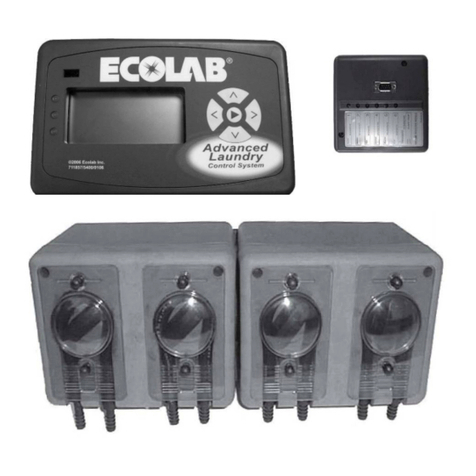
Ecolab
Ecolab Advanced Laundry Installation & operation manual
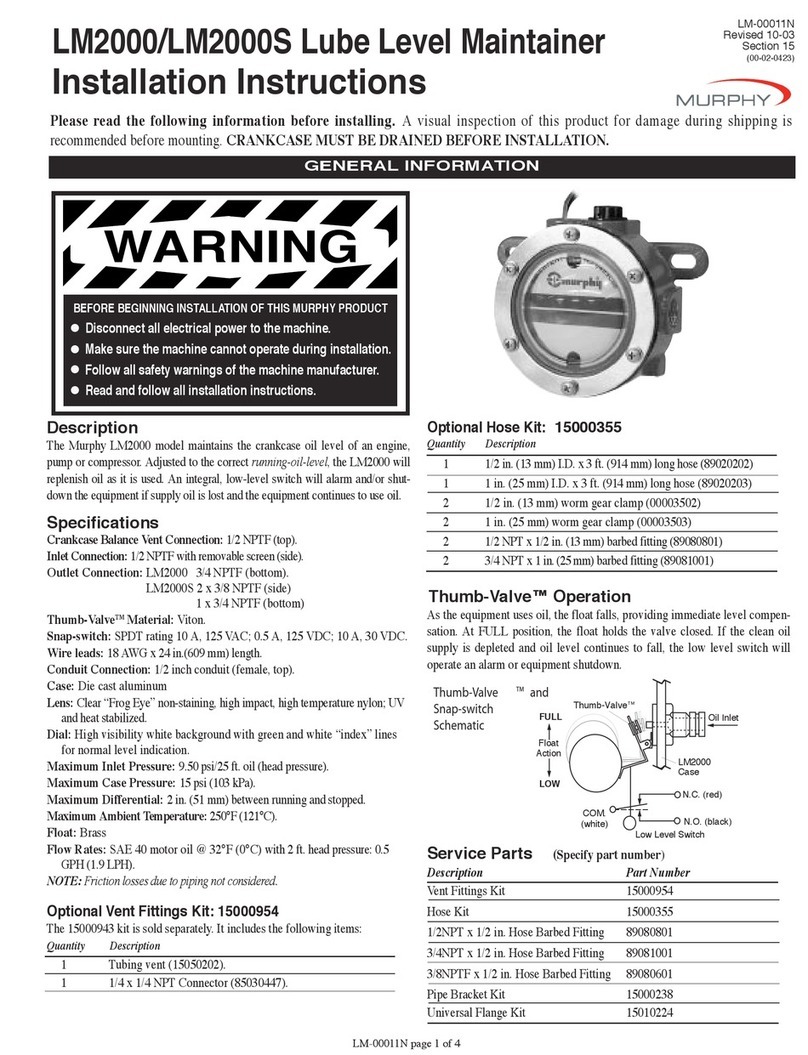
Murphy
Murphy Lube Level Maintainer LM2000 installation instructions
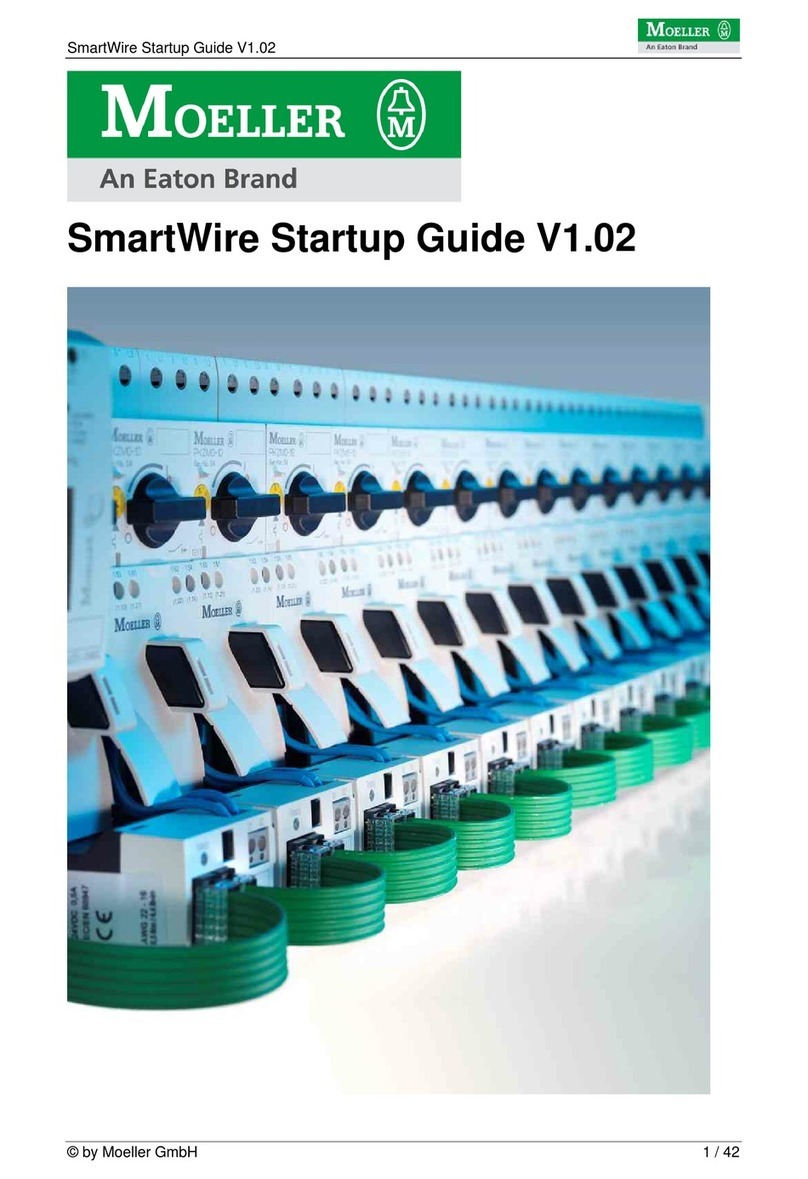
Moeller
Moeller SmartWire Startup guide
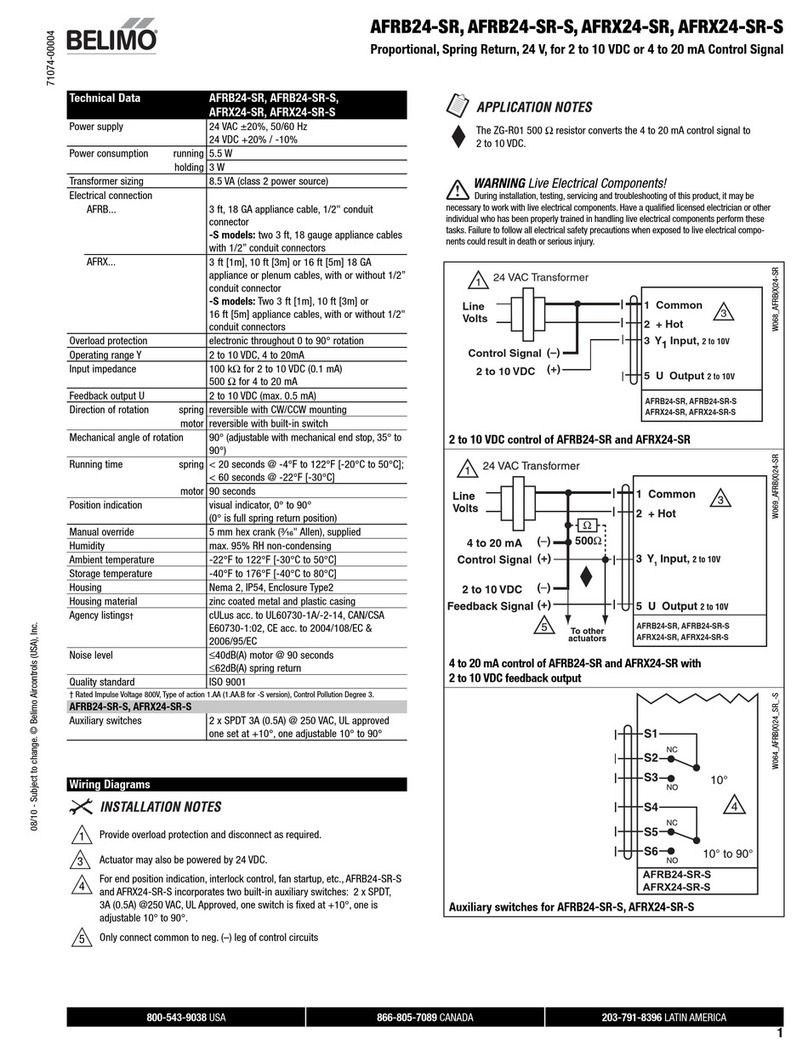
Belimo
Belimo AFRB24-SR-S Technical data

Schako
Schako EasyS-H01 user manual

Marantz
Marantz AV9000 Specifications
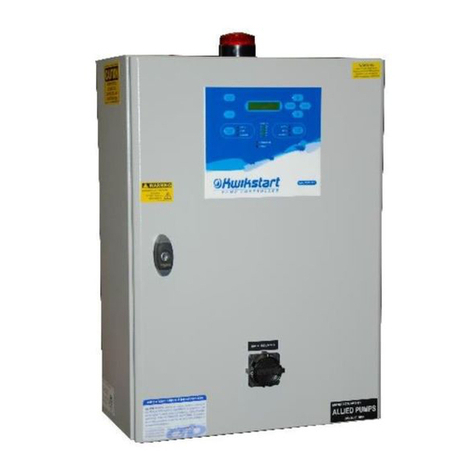
Allied Pumps
Allied Pumps Logikos Operation & maintenance manual
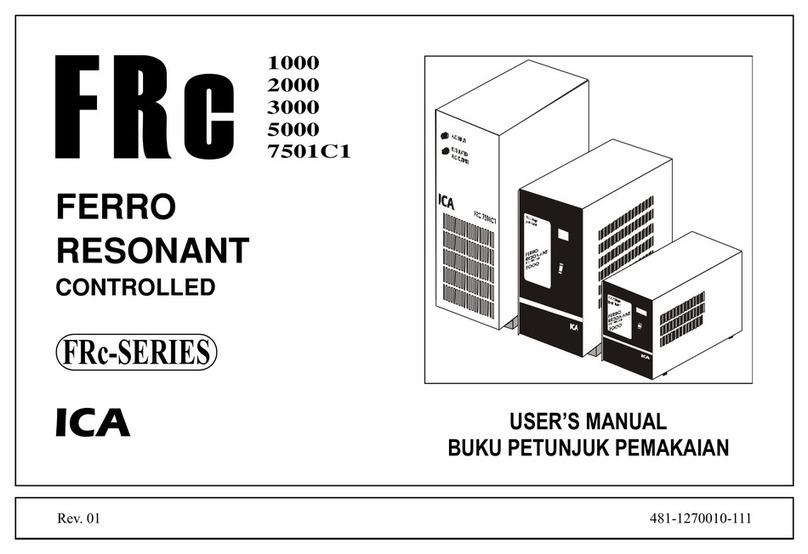
ICA
ICA FRc Series user manual
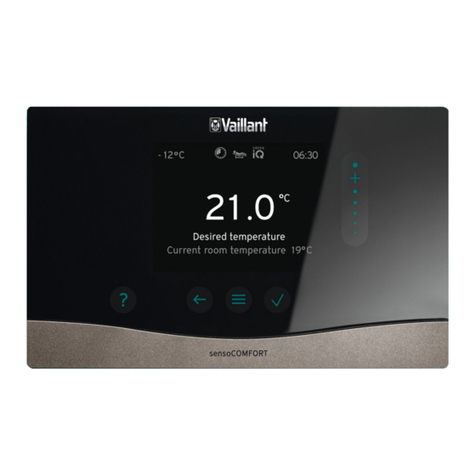
Vaillant
Vaillant VR 92 Operating and installation instructions
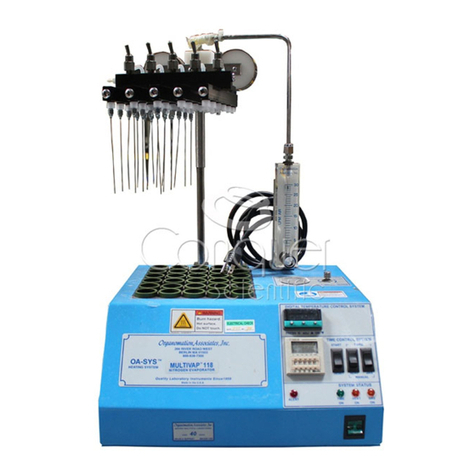
Organomation Associates
Organomation Associates MULTIVAP 118 instruction manual



